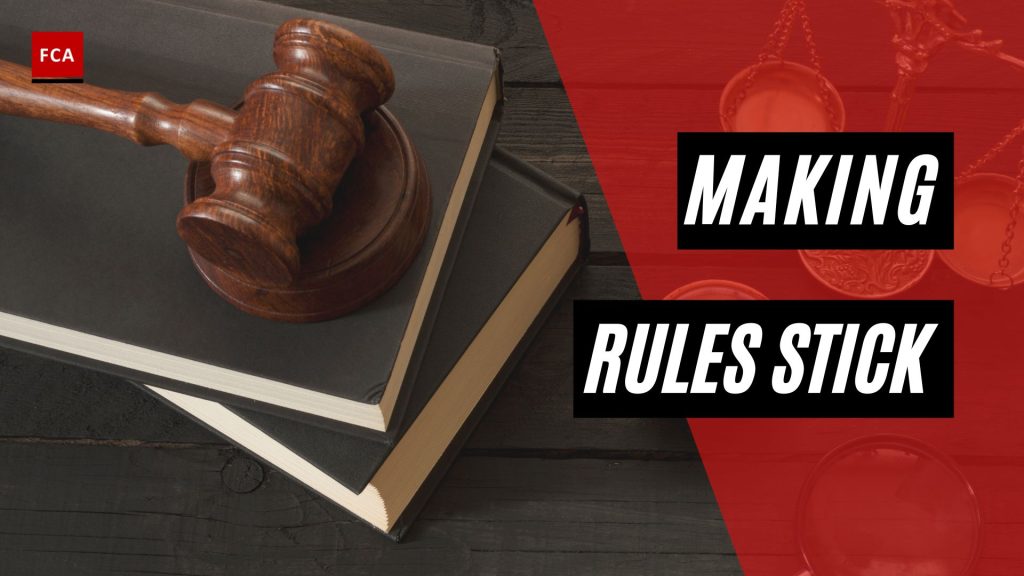The Board of Directors makes rules stick or ensures that management defines and implements compliance rules. Management defines and implements the rules in the organization by considering the organizational hierarchy and operational activities.
The relevant compliance sources are identified to define the rules to stick to, including laws, regulations, standards, and other industry requirements. It is imperative to understand that all the employees in the organization are responsible for ensuring compliance with the laws, regulations, and rules that apply to corporates.

Making Rules Stick: How Rules Are Made
In collaboration with its management team, the company’s Chief Executive Officer establishes the rules in the form of internal compliance policies, processes, procedures, and systems and cumulatively works as a reference source for the employees and staff to ensure the applicable corporate compliance requirements. It is important to understand that the top management, including the CEO or Board of Directors, is responsible for setting the rules for the employees and staff.
The regulators set compliance rules and must comply with the industry and the organizations operating within that industry. Rules are set for transparent business activities and better customer service. Around these major regulatory rules, the regulators introduce other rules for compliance by the organizations and businesses.
Compliance rules are made according to the nature of the business activities. For example, the company operating in the transport and shipping business would face the requirements of the right use of packaging for materials coverage, right transport documentation, delivery at the right location, etc. Without these rules, the transport and shipping company cannot survive.
Compliance rules for a company operating in an industry-centric on the customer or public service are required to set rules for compliance with requirements related to providing satisfactory services to the customers and public. For example, the company operating in the health and safety industry must set the compliance rules around health and safety laws and regulations that apply to the company and the sector. The management manages the daily business affairs and takes decisions related to the company.
At the same time, the compliance officer advises the management concerning corporate compliance, action in cases of identified irregularities, defining corrective action, education, etc. The CEO’s role is to provide the enabling environment and information for decision-making by the management, including corporate compliance risk assessment and management.
Everybody in the organization should abide by the compliance rules, report every violation, and implement concrete compliance activities within their domains of work. Still, the compliance officer is responsible for creating ethics and compliance programs and monitoring the compliance of the organization and the employees with the established norms.
The organizations are required to implement strong corporate compliance governance, policies, and processes to foster the culture of corporate compliance. Without sound regulatory and supervisory compliance structures, the negligent behavior of employees or staff towards corporate compliance may lead to the cancellation of licenses or inspections by the regulatory authorities, leading to penalties. Applying corporate compliance regulations requires safeguarding the interest of regulators, prospective investors, clients, creditors, and other stakeholders.

As a regulatory requirement, to reasonably deal with clients, it is mandatory for companies, especially financial institutions, to have themselves credit rated by the approved credit rating agency. The credit rating will be an ongoing process where it must be updated regularly, such as within six months from the date of each financial year, and the company’s rating report should be submitted to the financial market regulatory authority of the jurisdiction. The credit rating of the company should be made public. The companies shall promulgate their credit rating in their published annual and quarterly financial statements.
Laws and regulations require that companies refrain from adopting practices that would either artificially or temporarily show an ostensibly different financial position in the financial statements. Companies must show their deposits, investment transactions, assets, provisioning, operating and net profits, or any other method to artificially inflate the financial position to attract potential clients or investors.
Regarding the investment limits, the company makes rules for the investments prescribed in the corporate compliance policies and procedures where companies are restricted from investing the funds over the prescribed percentages of the aggregate equity of the respective company.
Final Thoughts
Effective business rules assist in setting expectations and providing guidelines for how work will be completed. Business rules must also be used to ensure that an organization complies with local, state, and federal regulatory requirements and guidelines, or they may address project governance.
Organizational leaders frequently use business rules to establish safety in conflict resolution, reduce errors, and avoid the need for litigation.








